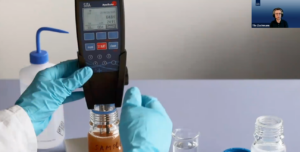Surface Tension
Surface tension is a physical property of liquids that describes the elastic tendency of a fluid surface. This phenomenon is caused by the cohesive forces between liquid molecules. In simpler terms, surface tension is the force that makes the surface of a liquid behave like a stretched elastic membrane.
Why Surface Tension Matters
- Liquid Behavior: Surface tension influences how liquids spread, form droplets, and interact with other materials.
- Industrial Processes: Surface tension plays a crucial role in processes such as coating, painting, and inkjet printing.
- Biology and Medicine: In biological systems, surface tension is critical in the functioning of lungs and the formation of cell membranes.
Measuring Surface Tension
There are several methods to measure surface tension, each with specific applications and levels of precision:
- Pendant Drop Method: Measures the shape of a droplet hanging from a syringe. The shape of the droplet is analyzed to determine the surface tension.
- Wilhelmy Plate Method: Uses a thin plate that is partially submerged in the liquid. The force needed to pull the plate from the liquid surface is measured.
- Capillary Rise Method: Involves measuring the height a liquid rises or falls in a capillary tube due to surface tension.
- Bubble Pressure Tensiometer: Measures the maximum pressure inside a bubble formed at the tip of a capillary submerged in the liquid. This pressure is directly related to the surface tension.

Surfactants
Surfactants (surface-active agents) are compounds that lower the surface tension between two substances, such as between a liquid and a gas or a liquid and a solid. They have both hydrophilic (water-attracting) and hydrophobic (water-repelling) parts.
Types of Surfactants
- Anionic Surfactants: Carry a negative charge and are commonly used in detergents and soaps.
- Cationic Surfactants: Carry a positive charge and are used in fabric softeners and disinfectants.
- Nonionic Surfactants: Do not carry any charge and are often used in household cleaners and personal care products.
- Amphoteric Surfactants: Can carry either a positive or negative charge depending on the pH of the solution, used in shampoos and skin care products.
Role of Surfactants
- Cleaning: Surfactants reduce surface tension, allowing water to spread and penetrate dirt and grease more effectively.
- Emulsification: They help mix oil and water by stabilizing the mixture, which is essential in products like mayonnaise and lotions.
- Foaming: Surfactants enable the formation of foam, which is important in products like shaving cream and fire-fighting foams.
- Dispersion: They help to disperse particles evenly in a liquid, useful in paints and pharmaceuticals.
Measuring the Effect of Surfactants on Surface Tension
The addition of surfactants to a liquid reduces its surface tension. This effect can be measured using the same methods mentioned earlier. The measurement helps determine the concentration of surfactant needed for a specific application and its effectiveness.
Applications:
Surfactant Solutions:
-
- Evaluating the effectiveness of surfactants by observing how they reduce surface tension over time.
Emulsions and Foams:
-
- Studying the stability of emulsions and foams, which are affected by surfactant properties.
Pharmaceuticals and Cosmetics:
-
- Ensuring product consistency and quality by controlling surface tension.
Key Points
- Surfactants reduce surface tension: Tensiometers and the bubble pressure method are essential tools for measuring this reduction, which indicates surfactant effectiveness.
- Dynamic vs. Static Measurement: The bubble pressure method provides dynamic measurements of surface tension, offering insights into the time-dependent behavior of surfactants.
- Versatility: Both methods are applicable in various industries, from pharmaceuticals to cosmetics, where control of surface tension is crucial for product performance.
By using these methods, industries can optimize formulations and ensure the desired performance of surfactants in their products.
In summary, understanding and measuring surface tension and the role of surfactants are crucial for various industrial, biological, and environmental applications. These measurements help in designing and optimizing products and processes that rely on the interaction of liquids with other substances.
